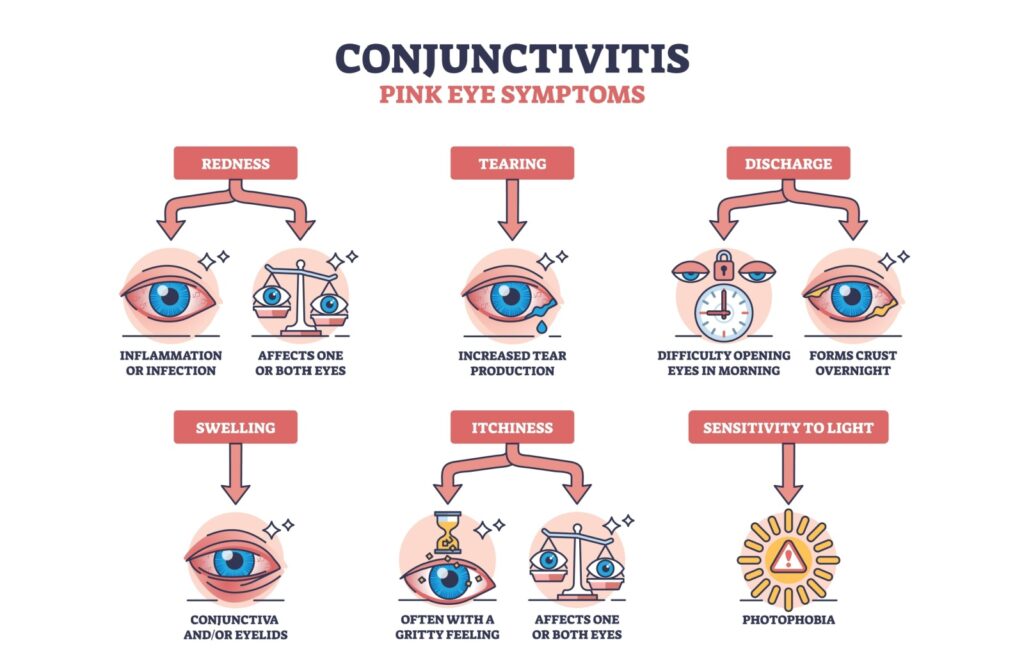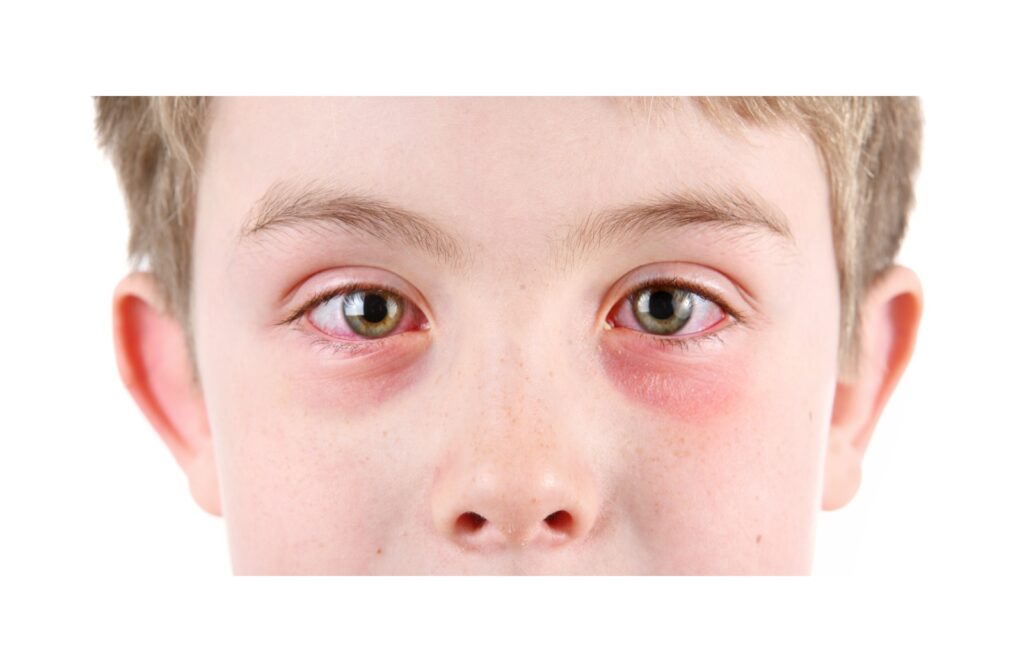You finally cleared up pink eye—then it came back again.
Waking up with red, itchy, or sticky eyes is frustrating, especially when you thought you had already dealt with it.. Pink eye—or conjunctivitis—is a common problem, but when it keeps coming back, it can feel like a cycle you can’t break. You may wonder if you’re doing something wrong or if there’s a deeper issue.
Your pink eye may return because the initial infection wasn’t fully treated, you were re-exposed to the germs, or you have an underlying eye condition that makes you more susceptible. A comprehensive eye exam is a great way to uncover the root cause and find a path toward lasting relief.
At Northern Lights Eyecare, we get to know you and your vision needs personally. Your eyes deserve more than just a test.
The Different Types of Pink Eye
Viral Conjunctivitis
This is the most common type of pink eye—and as a viral infection, it’s very contagious. It often appears with a cold or respiratory infection. Your eyes may look pink and feel watery or gritty.
Symptoms often include:
- Watery discharge
- Redness in the white of the eye
- A gritty or sandy feeling
- Swollen eyelids
It usually starts in one eye and can quickly spread to the other. Since a virus causes it, antibiotics won’t work on it.
Bacterial Conjunctivitis
Bacterial pink eye is also highly contagious and is caused by bacteria. It can create more mucus or pus than the viral kind. This discharge can sometimes make your eyelids stick together, especially when you wake up.
This type often needs prescription eye drops to clear the infection. It’s important to see an eye doctor for a professional diagnosis to know for sure which type you have.
Allergic Conjunctivitis
If your eyes are itchy, red, and watery, it might be due to allergies. Things like pollen, pet dander, or dust can trigger this reaction. Unlike viral or bacterial pink eye, this type is not contagious.
Allergic pink eye usually affects both eyes at the same time. It may also come with other allergy symptoms like a stuffy nose or sneezing. For more information on the different causes and treatments, the Canadian Association of Optometrists provides a helpful overview of conjunctivitis.
Reasons for Recurring Pink Eye
Incomplete Treatment
Sometimes pink eye comes back because the first infection didn’t completely go away. You might feel better and stop your treatment too soon. It’s important to use your eye drops for the full time prescribed, even if your symptoms improve.
Stopping treatment early can allow the bacteria to return and cause a new infection. Always follow the instructions provided by your eye care professional.
Getting Reinfected by Accident
You can get pink eye again if you come back into contact with the virus or bacteria. This can happen if you touch your eyes with unwashed hands. It also happens from contaminated items like towels, pillowcases, or makeup.
To avoid this, wash your hands often. You should also change your linens and avoid sharing personal items when you have an infection.
Underlying Health Conditions
In some cases, recurring pink eye can be a sign of another issue. Conditions like blepharitis—eyelid inflammation—or even dry eye can make you more likely to get infections. These issues can create an environment where germs can thrive.
If your pink eye keeps returning, a thorough eye exam can help identify any underlying causes. It’s important to understand what can be mistaken for pink eye, as this is key to finding a long-term solution.
Pink Eye’s Connection to Other Eye Conditions
How Dry Eyes Can Lead to Pink Eye
If you have dry eye disease, you might be more prone to infections like pink eye. A healthy tear film helps protect your eyes from germs. When your eyes are dry, this protective barrier is weaker.
Treating dry eye can help make your eyes more comfortable. It can also strengthen their natural defence against infections.
Consider Your Contact Lens Habits
Contact lenses can sometimes increase your risk of eye infections if not cared for properly. It’s important to follow hygiene rules—like washing your hands and cleaning your lenses as directed. A proper contact lens fitting helps ensure your lenses are right for your eyes.
If you get pink eye, you should stop wearing your contacts until your eye doctor says it’s safe to start again. You’ll likely need to throw away the pair you were wearing when the infection began.
When You Need Emergency Eye Care
Some eye symptoms require immediate attention. If you experience severe eye pain, changes in your vision, or high sensitivity to light, these may be symptoms of an urgent eye problem, and it’s time to seek emergency eye care.
Our clinic is here to help with urgent eye problems. Prompt care can help protect your vision and get you on the path to recovery faster.

How an Eye Exam Can Help
Get a Clear Diagnosis
It’s hard to tell what kind of pink eye you have on your own. At our Prince Albert eye clinic, we can perform an in-depth examination of your eyes to find the exact cause. An accurate diagnosis is the first step toward effective treatment.
We look at your eye’s health up close to see what’s really going on. This helps us separate an infection from an allergic reaction or another irritant.
Receive a Custom Treatment Plan
Once we know the cause, we can create a personalized treatment plan for you. This might involve prescription drops for a bacterial infection or specific advice for managing allergies. We develop a plan that fits your specific needs.
Our goal is to help you feel better and reduce the chance of the problem coming back. Our team is dedicated to providing gentle care in a welcoming environment.
Rule Out Other Eye Health Issues
A comprehensive eye exam does more than just look at your current symptoms. We check your overall eye health to make sure there are no other problems. This is an important part of your routine care.
We can also talk about other aspects of your vision health during your visit. This can include anything from dry eye therapy to eye strain if you have questions.
A Note on Your Family’s Eye Health
Pink Eye & Children
Pink eye is very common in children because it spreads easily in schools and daycares. Kids often touch their eyes, which helps the germs move from person to person. Teaching them good hand-washing habits can make a big difference.
If you think your child has pink eye, it’s a good idea to have it checked out. We can help you understand how to manage the infection and when it’s safe for them to return to school.
The Value of Children Eye Exams
Regular check-ups are important for everyone, especially children whose eyes are still developing. Routine children eye exams in Prince Albert can catch potential issues early on. Healthy eyes are important for learning and development.
These exams are about more than just checking for clear vision. We look at the overall health of your child’s eyes to support them as they grow.
Support for Long-Term Vision
If your ‘pink eye’ keeps coming back, you’re not alone—and using the wrong treatment could be part of the problem. Recurrence often signals an underlying issue that requires more than over‑the‑counter drops. Our team at Northern Lights Eyecare takes a comprehensive approach to diagnosing these stubborn cases.
We’ll examine your symptoms, rule out mimics (like dry eye, blepharitis, or allergies), and build a plan customized for you or your family’s needs. Whether it’s ongoing monitoring, specialized treatments, or preventive steps, we’re committed to getting your eyes back to comfort and clarity.
Schedule your eye exam today and let us help you break the cycle of recurring pink eye.


